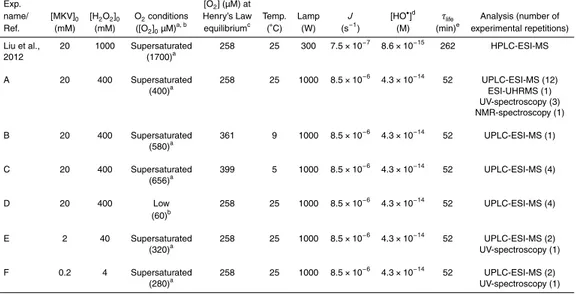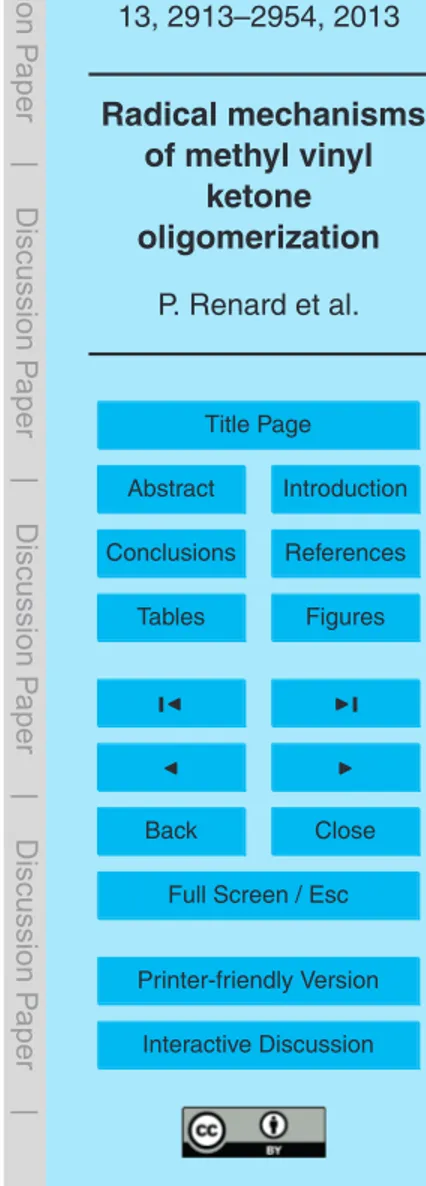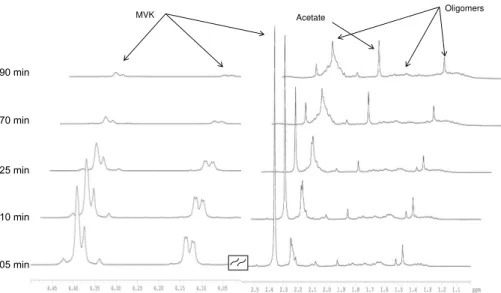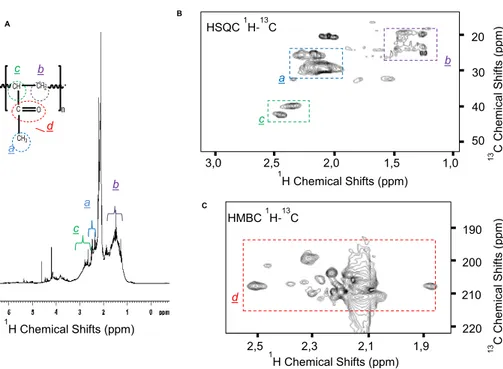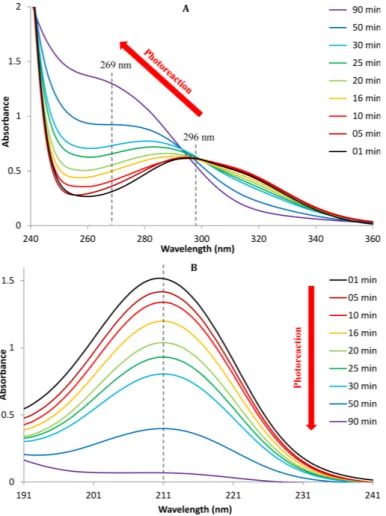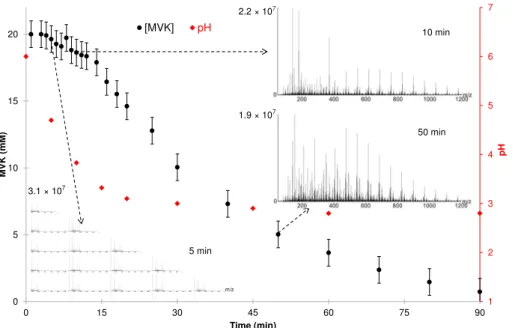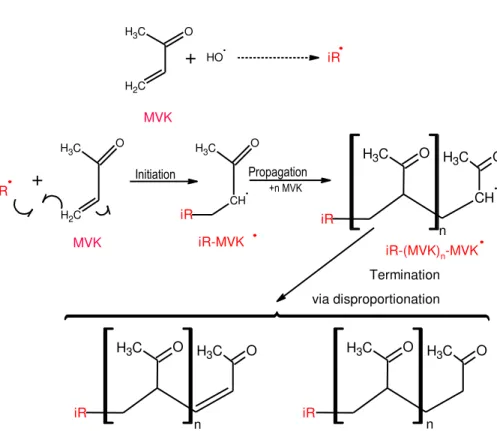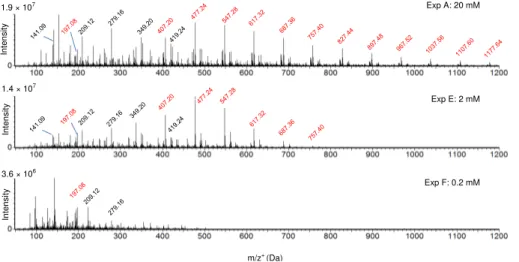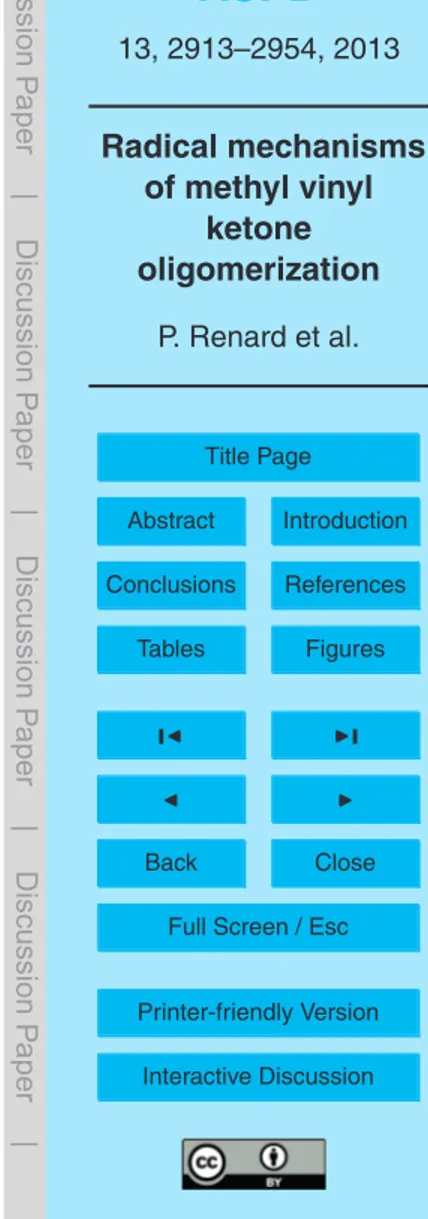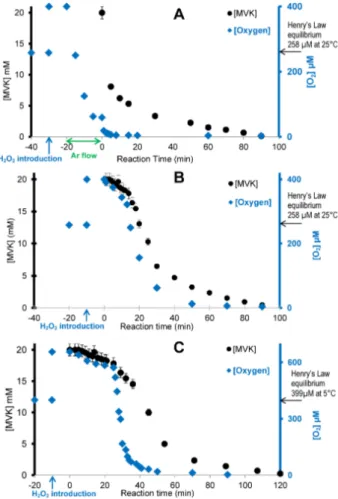ACPD
13, 2913–2954, 2013Radical mechanisms of methyl vinyl
ketone oligomerization
P. Renard et al.
Title Page
Abstract Introduction
Conclusions References
Tables Figures
◭ ◮
◭ ◮
Back Close
Full Screen / Esc
Printer-friendly Version Interactive Discussion
Discussion
P
a
per
|
Dis
cussion
P
a
per
|
Discussion
P
a
per
|
Discussio
n
P
a
per
|
Atmos. Chem. Phys. Discuss., 13, 2913–2954, 2013 www.atmos-chem-phys-discuss.net/13/2913/2013/ doi:10.5194/acpd-13-2913-2013
© Author(s) 2013. CC Attribution 3.0 License.
Atmospheric Chemistry and Physics Discussions
This discussion paper is/has been under review for the journal Atmospheric Chemistry and Physics (ACP). Please refer to the corresponding final paper in ACP if available.
Radical mechanisms of methyl vinyl
ketone oligomerization through aqueous
phase OH-oxidation: on the paradoxical
role of dissolved molecular oxygen
P. Renard1, F. Siekmann1, A. Gandolfo1, J. Socorro1, G. Salque3, S. Ravier1, E. Quivet1, J.-L. Cl ´ement2, M. Traikia5, A.-M. Delort5,6, D. Voisin3, R. Thissen4,
and A. Monod1
1
Aix-Marseille Universit ´e, CNRS, LCE FRE 3416, 13331 Marseille, France
2
Aix-Marseille Universit ´e, CNRS, ICR UMR 7273, 13397 Marseille, France
3
Universit ´e Joseph Fourier, Grenoble 1/CNRS-INSU, Laboratoire de Glaciologie et G ´eophysique de l’Environnement, 54 rue Moli `ere, 38402 Saint-Martin-d’H `eres, France
4
Institut de Plan ´etologie et d’Astrophysique de Grenoble (IPAG) UMR5274, UJF-Grenoble1/CNRS-INSU, Grenoble, 38041, France
5
Clermont Universit ´e, Universit ´e Blaise Pascal, Institut de Chimie de Clermont-Ferrand, BP 10448, 63000 Clermont-Ferrand, France
6
ACPD
13, 2913–2954, 2013Radical mechanisms of methyl vinyl
ketone oligomerization
P. Renard et al.
Title Page
Abstract Introduction
Conclusions References
Tables Figures
◭ ◮
◭ ◮
Back Close
Full Screen / Esc
Printer-friendly Version Interactive Discussion
Discussion
P
a
per
|
Dis
cussion
P
a
per
|
Discussion
P
a
per
|
Discussio
n
P
a
per
|
Received: 17 December 2012 – Accepted: 3 January 2013 – Published: 28 January 2013 Correspondence to: P. Renard (renard.pascal@yahoo.fr), A. Monod
(anne.monod@univ-amu.fr)
ACPD
13, 2913–2954, 2013Radical mechanisms of methyl vinyl
ketone oligomerization
P. Renard et al.
Title Page
Abstract Introduction
Conclusions References
Tables Figures
◭ ◮
◭ ◮
Back Close
Full Screen / Esc
Printer-friendly Version Interactive Discussion
Discussion
P
a
per
|
Dis
cussion
P
a
per
|
Discussion
P
a
per
|
Discussio
n
P
a
per
|
Abstract
It is now accepted that one of the important pathways of Secondary Organic Aerosol (SOA) formation occurs through aqueous phase chemistry in the atmosphere. How-ever, the liquid phase chemical mechanisms leading to macromolecules are still not well understood. Forα-dicarbonyl precursors, such as methylglyoxal and glyoxal,
radi-5
cal reactions through OH-oxidation produce oligomers, irreversibly and faster than ac-cretion reactions. Methyl vinyl ketone (MVK) was chosen in the present study as it is anα,β-unsaturated carbonyl that can undergo such reaction pathways in the aqueous phase and forms even high molecular weight oligomers. We present here experiments on the aqueous phase OH-oxidation of MVK, performed under atmospheric relevant
10
conditions. Using NMR and UV absorption spectroscopy, high and ultra-high resolu-tion mass spectrometry, we show that the fast formaresolu-tion of oligomers up to 1800 Da is due to radical oligomerization of MVK, and 13 series of oligomers (out of a total of 26 series) are identified. The influence of atmospherically relevant parameters such as temperature, initial concentrations of MVK and dissolved oxygen are presented and
15
discussed. In agreement with the experimental observations, we propose a chemical mechanism of OH-oxidation of MVK in the aqueous phase that proceeds via radical oligomerization of MVK on the olefin part of the molecule. This mechanism highlights the paradoxical role of dissolved O2: while it inhibits oligomerization reactions, it con-tributes to produce oligomerization initiator radicals, which rapidly consume O2, thus
20
ACPD
13, 2913–2954, 2013Radical mechanisms of methyl vinyl
ketone oligomerization
P. Renard et al.
Title Page
Abstract Introduction
Conclusions References
Tables Figures
◭ ◮
◭ ◮
Back Close
Full Screen / Esc
Printer-friendly Version Interactive Discussion
Discussion
P
a
per
|
Dis
cussion
P
a
per
|
Discussion
P
a
per
|
Discussio
n
P
a
per
|
1 Introduction
Although Secondary Organic Aerosol (SOA) represents a substantial part of organic aerosol, which affects air quality, climate and human health, the understanding of its formation pathways and its properties is still limited due to the complexity of the physic-ochemical processes involved. It is now accepted that one of the important pathways of
5
SOA formation occurs through aqueous phase chemistry which is a favorable medium for the formation of oligomers (Hallquist et al., 2009; Carlton et al., 2009; Ervens et al., 2011). An oligomer is a molecule that consists of a few monomer units (roughly up to 30). Such aqueous phase chemistry is obviously relevant to clouds and fogs, but not limited to them, by far: it was shown that water can make up most of the aerosol
10
mass, and in many cases largely exceeds the sum of all other particle species includ-ing organic matter (Tan et al., 2012; Liao and Seinfeld, 2005). This actually extends the relevance of aqueous phase processes from water vapor supersaturated regions of the atmosphere to high relative humidity regions, which represents a high fraction of the at-mosphere. However, the aqueous phase chemical mechanisms leading to oligomers or
15
macromolecules such as HULIS are still not well understood. Several accretion mech-anisms such as aldol condensation, acetal formation or esterification have been ten-tatively proposed, but it was recently recognized that aqueous phase photochemistry plays a crucial role in oligomer development. For α-dicarbonyl precursors, such as methylglyoxal (Tan et al., 2012) and glyoxal (Lim et al., 2010), radical reactions through
20
OH-oxidation produce oligomers, irreversibly and faster than accretion reactions. Recent studies showed that aerosol water-soluble organic carbon (WSOC) is a com-plex mixture that contains thousands of organic compounds among which a majority is aliphatic to olefinic in nature, and indicate significant non-oxidative reaction pathways for the formation of high molecular weight WSOC components (Mazzoleni et al., 2012).
25
ACPD
13, 2913–2954, 2013Radical mechanisms of methyl vinyl
ketone oligomerization
P. Renard et al.
Title Page
Abstract Introduction
Conclusions References
Tables Figures
◭ ◮
◭ ◮
Back Close
Full Screen / Esc
Printer-friendly Version Interactive Discussion
Discussion
P
a
per
|
Dis
cussion
P
a
per
|
Discussion
P
a
per
|
Discussio
n
P
a
per
|
The aim of the present study is to determine the radical mechanism involved in the oligomerization of MVK, and to identify the oligomers formed via this chemistry. The influence of atmospherically relevant parameters such as temperature, reactant initial concentrations and dissolved oxygen concentrations is studied.
2 Experimental
5
We used a photoreactor to simulate the aqueous phase photooxidation of MVK under atmospheric conditions. HO•radicals were generated from H2O2photolysis. In order to determine the reaction mechanism, we used a complete set of analytical strategies to identify the oligomers produced. Aqueous aliquots sampled at different photoreaction times were analyzed by mass spectrometry, UV absorbance spectroscopy and NMR.
10
In order to test our radical mechanism for MVK oligomerization, its aqueous phase pho-tooxidation was studied under various relevant conditions of temperature, MVK initial concentrations, and above all, dissolved oxygen concentrations.
2.1 Photoreactor
The photoreactor set-up we used is based on the one described by Liu et al. (2009,
15
2012) with some modifications. It is a 450 cm3 Pyrex thermostated photoreactor. The arc light source (LSH 601, Lot Oriel) is equipped with a 1000 W xenon arc lamp (LSB 551, Lot Oriel). A glass filter (ASTM 892 AM 1.5 standard) was used to remove the UV irradiation below 300 nm, resulting in an irradiance spectrum comparable to that of the sun at sea level, for a 48.3◦ zenith angle, but more intense (less than an order of
20
magnitude).
ACPD
13, 2913–2954, 2013Radical mechanisms of methyl vinyl
ketone oligomerization
P. Renard et al.
Title Page
Abstract Introduction
Conclusions References
Tables Figures
◭ ◮
◭ ◮
Back Close
Full Screen / Esc
Printer-friendly Version Interactive Discussion
Discussion
P
a
per
|
Dis
cussion
P
a
per
|
Discussion
P
a
per
|
Discussio
n
P
a
per
|
concentrations, and thus led to faster MVK degradation and kept artifacts due to H2O2 reactivity to a minimum.
A 50 mL gas space was left over the liquid level. The loss of aqueous MVK to the gas phase was insignificant, based on its Henry’s Law constant (41 M atm−1at 25◦C; Iraci et al., 1999) and on control experiments.
5
2.2 Experimental conditions
All experiments started with irradiation of UHQ water (18.2 Mohm cm, Millipore), then H2O2 (30 %, non-stabilized, Acros) was introduced, photolysed for 10 min until photo-stationary conditions were reached. MVK (99 %, Sigma Aldrich) was finally introduced at time noted 0 min. The experimental conditions (temperature, concentrations) were
10
chosen in order to be representative of cloud droplets or deliquesced aerosol particles conditions.
2.2.1 Control experiments
To check that the observed products resulted from the aqueous phase OH-oxidation of MVK, two control experiments were conducted: (1) MVK (20 mM)+H2O2(400 mM)
15
under dark conditions, and (2) direct photolysis of MVK (20 mM). MVK was not signifi-cantly consumed either in presence of H2O2in the dark (1) or under direct irradiation (2). Additionally, we performed (3) direct photolysis of H2O2 (400 mM) in absence of MVK, and the observed decrease of H2O2 concentrations allowed us to determine its photolysis rate constantJ (see Table S1 in the Supplement). The duration of these
20
three control experiments was 300 min, consistent with the reaction time of the actual MVK photooxidation experiments.
2.2.2 Initial concentrations of reactants
Tan et al. (2010) have shown the important impact of initial concentrations on oligomer formation for α-dicarbonyls. Our experiments were thus carried out with various
ACPD
13, 2913–2954, 2013Radical mechanisms of methyl vinyl
ketone oligomerization
P. Renard et al.
Title Page
Abstract Introduction
Conclusions References
Tables Figures
◭ ◮
◭ ◮
Back Close
Full Screen / Esc
Printer-friendly Version Interactive Discussion
Discussion
P
a
per
|
Dis
cussion
P
a
per
|
Discussion
P
a
per
|
Discussio
n
P
a
per
|
MVK initial concentrations i.e. 0.2 mM, 2 mM and 20 mM (corresponding to 9.6 to 960 mg C L−1). These concentrations are representative of the total WSOC concen-trations in atmospheric water from precipitation, cloud droplets to deliquesced aerosol particles (Decesari et al., 2005; Hennigan, et al., 2009).
We chose the ratio [H2O2]0/[MVK]0=20 to favor HO •
reaction toward MVK over its
5
reaction with H2O2 (reaction R2, in Table S1 in the Supplement) by more than 90 %. Under these conditions, we estimated HO•concentrations to approximately 5×10−14M, which fall in the range of the estimated values for cloud droplets to deliquesced aerosol particles conditions by models (Herrmann et al., 2010; Ervens and Volkamer, 2010).
2.2.3 Temperature, pH and dissolved oxygen
10
Temperature, pH and dissolved oxygen concentrations were continuously monitored in the solution. Three relevant temperatures were tested, 5◦C, 9◦C and 25◦C. The pH of the unbuffered solution (monitored with a Consort C3020 multi-parameter ana-lyzer) decreased from 6 to 3 within 90 min of photoreaction (Experiments A, B and C: [MVK]0=20 mM, at 25◦C, 9◦C and 5◦C; Table 1).
15
At 25◦C, in experiments where dissolved oxygen concentrations were not con-strained (Experiments A, B, C, E and F in Table 1), these concentrations were at Henry’s law equilibrium with atmospheric O2 in UHQ water. After H2O2 introduction (up to 400 µM in experiment A) the dissolved O2concentrations were supersaturated, due to H2O2photooxidation (reactions R3 and R4 in Table S1 in the Supplement), and
20
then they decreased down to nearly 0 during MVK photooxidation. Thus, for these ex-periments, O2was supersaturated when MVK was introduced (called “supersaturated initial O2concentrations” experiments in the following). Due to this high variability, and also because oxygen is known as a radical polymerization inhibitor (Odian, 2004), we investigated the influence of initial dissolved oxygen concentrations.
25
ACPD
13, 2913–2954, 2013Radical mechanisms of methyl vinyl
ketone oligomerization
P. Renard et al.
Title Page
Abstract Introduction
Conclusions References
Tables Figures
◭ ◮
◭ ◮
Back Close
Full Screen / Esc
Printer-friendly Version Interactive Discussion
Discussion
P
a
per
|
Dis
cussion
P
a
per
|
Discussion
P
a
per
|
Discussio
n
P
a
per
|
stopped in order to prevent MVK from evaporation, and the samples were collected using a syringe through a septum to avoid atmospheric O2entering the reactor.
2.3 Mass Spectrometry analyses of the solution
We used an ultra-high performance liquid chromatographic column coupled to a time of flight mass spectrometer equipped with a soft ionization electrospray source, noted
5
UPLC-ESI-MS (Synapt-G2 HDMS, Waters). This instrument enabled us to evidence the oligomerization dependence on oxygen, and to follow the oligomerization kinet-ics. One of the experiments A (at 25◦C, Table 1) was performed using an ultra-high resolution mass spectrometer coupled to an electrospray ionization source, noted ESI-UHRMS (LTQ-Orbitrap-XL, Thermo).
10
2.3.1 UPLC-ESI-MS analyses
Aqueous samples (taken from the photoreactor) were analyzed for organics species using Quadrupole-Time-of-Flight Mass Spectrometry and Ion Mobility Spectrometry (Synapt G2 HDMS, Waters, MA, USA) combined with electrospray ion (ESI) source and coupled with an Acquity UPLC system (Waters). The mass spectrometer was used
15
in its resolution mode, up to 18 000 FWHM (Full width at half maximum) at 400 Da and allowed the determination of elemental composition of some organic species, using the I-FIT software. The I-FIT isotope predictive filtering is a strategy to reduce the number of proposed elemental compositions using algorithms to estimate the number of carbon, oxygen or sulphur atoms in an unknown molecule based on the mass of the
20
molecular ion and the relative intensity of the 1st and 2nd isotopes (Hobby, 2005). The chromatographic separations were carried out on a HSS T3 UPLC column (Wa-ters Acquity High Strength Silica T3, 2.1×100 mm, 1.8 µm) at 40◦C. The mobile phases consisted in (A) 0.1 % formic acid in water (Fluka, 98 %) and (B) Acetonitrile (CAN; Op-tima LC-MS, Fischer). The gradient elution was performed at a flow rate of 600 µL min−1
ACPD
13, 2913–2954, 2013Radical mechanisms of methyl vinyl
ketone oligomerization
P. Renard et al.
Title Page
Abstract Introduction
Conclusions References
Tables Figures
◭ ◮
◭ ◮
Back Close
Full Screen / Esc
Printer-friendly Version Interactive Discussion
Discussion
P
a
per
|
Dis
cussion
P
a
per
|
Discussion
P
a
per
|
Discussio
n
P
a
per
|
using 5 to 95 % of B within 7 min and held at 95 % of B for 1.5 min. The sample injection volume was 10 µL.
The ESI source of this instrument contains two individual orthogonal sprays. One spray is for the column eluent, and the other one is for the internal standard called lock-mass. During each chromatographic run, leucine enkephalin (2 ng µL−1, C28H37N5O7,
5
MW 555.27, Waters Q-ToF product) was used for lock-mass correction to obtain ac-curate masses for each organic component eluting from the column. The lock-mass syringe pump was operated at 7 µL min−1. A solution of sodium formate (CO2HNa, Wa-ters Q-ToF product) was infused daily in the ESI source to calibrate the instrument. Optimum ESI conditions were found using a 2.5 kV capillary voltage, 40 V sample cone
10
voltage, 450◦C desolvation temperature, 120◦C source temperature, 20 L h−1cone gas flow rate and 800 L h−1desolvation gas flow rate.
Data were collected from 50 to 1800 Da in the positive and negative ionization modes. All products were detected as their protonated molecules ([M+H]+) or sodium adducts ([M+Na]+) in the positive mode, and their deprotonated molecules ([M−H]−)
15
in the negative mode.
For experiments A (Table 1), complementary analyses were performed using MS/MS fragmentation to confirm the structure of the products. MS/MS experiments (below 200 Da) were carried out with a trap collision energy ramp from 5 to 20 eV. Additionally, traveling wave ion mobility allowed us to separate ions which had the same elemental
20
formula. The main parameters were the IMS Wave Velocity 650 m s−1 and the IMS Wave Height 40 V.
2.3.2 ESI-UHRMS analyses
One of the experiments A (at 25◦C, Table 1) was performed using an ultra-high reso-lution mass spectrometer coupled to an ESI source (LTQ-Orbitrap-XL, Thermo).
Aque-25
ACPD
13, 2913–2954, 2013Radical mechanisms of methyl vinyl
ketone oligomerization
P. Renard et al.
Title Page
Abstract Introduction
Conclusions References
Tables Figures
◭ ◮
◭ ◮
Back Close
Full Screen / Esc
Printer-friendly Version Interactive Discussion
Discussion
P
a
per
|
Dis
cussion
P
a
per
|
Discussion
P
a
per
|
Discussio
n
P
a
per
|
more stable operations. ACN was chosen against methanol as this latter was shown to occasionally induce esterification during the ionization (Bateman et al., 2008). Each sample was measured in the negative and positive ionization modes, with the follow-ing optimized settfollow-ings: source voltage: 3.5 kV, capillary temperature: 275◦C, tube lens voltage: 50 V, in the positive mode, and source voltage: 3.7 kV, tube lens voltage: 90 V
5
and same capillary temperature in the negative mode.
Transient acquisition time was set to 1s, which corresponds to a nominal resolution of 100 000 at 400 Da, and to observe individual peaks resolution (FWHM) typically better than 200 000 at 200 Da. Each spectrum was obtained by averaging 20 min of acquisition time, so as to increase theS/N ratio of the lower intensity peaks. Acquisition
10
was performed over two overlapping mass ranges: 50–300 Da and 150–1500 Da. This method overcomes transfer limitations of very wide mass ranges in the ion optics which guide the molecular ions through the LTQ to the Orbitrap mass analyzer.
External mass calibration was made daily by infusing a calibration mixture (L-methionine-arginyl-phenylalanyl-alanine, caffeine, and ultramark: MSCAL 5-10EA
Su-15
pelco) having peaks in the range 195 to 1921 Da. The obtained mass accuracy was as low as 2–5 ppm, and better for peaks with a relative intensity above 0.5 % (Makarov et al., 2006).
For our moderately complex mixture (∼6000 peaks), containing only O, C, H, and Na,
unambiguous elemental formula assignments were established below 350 Da within
20
1 mDa using a custom computer software (Attributor v1.05) developed by F. R. Orthous-Daunay (2011) and described in Danger et al. (2013). It is based on a suite of scripts that allow to evaluate the most probable attribution of a high resolution peak, based on its mass, the presence and relative intensity of isotopic peaks, as well as chemi-cal rules (nitrogen rule, even electron ions, etc.) Using a Kendrick analysis (Hughey
25
ACPD
13, 2913–2954, 2013Radical mechanisms of methyl vinyl
ketone oligomerization
P. Renard et al.
Title Page
Abstract Introduction
Conclusions References
Tables Figures
◭ ◮
◭ ◮
Back Close
Full Screen / Esc
Printer-friendly Version Interactive Discussion
Discussion
P
a
per
|
Dis
cussion
P
a
per
|
Discussion
P
a
per
|
Discussio
n
P
a
per
|
patterns. Typical standard deviation of the Kendrick mass defect in any such identified series was lower than 0.5 mDa which ensures the proper attribution of all the members of a series, to within less than 1 mDa in the full mass range explored (i.e. 50–1500 Da).
2.4 Spectroscopic analyses of the solution
2.4.1 UV Spectroscopy
5
UV absorption spectroscopy (Agilent 8453) was used in a wavelength range from 190 to 400 nm to monitor MVK concentrations and chemical structure changes dur-ing the reaction. Diluted in water, MVK shows, like all α,β-unsaturated ketones (Ya-dav, 2012), an intense absorption band (K-band;π→π∗ transition) at 211 nm (ε211=
7692 M−1cm−1) and a weak absorption band (R-band; n→π∗ transition) at 296 nm
10
(ε296=30 M −1
cm−1). Because the absorbance of H2O2 below 240 nm is intense (i.e. ε211=100 M
−1
cm−1), it was interfering with the π→π∗ transition of MVK under our experimental conditions where [H2O2]0/[MVK]0=20. A volume of catalase from bovine liver (C 3155, Sigma Aldrich) was added to each sample to quench efficiently the H2O2 absorbance signal within a few minutes (Li and Schellhorn, 2007).
15
2.4.2 NMR spectroscopy
One of the experiments A was analyzed using NMR spectroscopy (Table 1). The in-strument used was a Bruker Avance 500 MHz equipped with a 5 mm inverse-triple tuned (TXI) 1H/13C/15N with z-gradient coil probe. For 1-D 1H-Spectra, 128 scans were collected with an impulsion time of 7.5 µs, a relaxation delay of 5 s, an
acquisi-20
tion time of 4.67 s, a spectral window of 5000 Hz and 64 K data points zero-filled to 128 K before Fourier transformation with 0.3 Hz line broadening. For 2-D homonuclear (COSY and TOCSY) and heteronuclear (1H/13C HSQC and HMBC) experiments were performed with quadrature phase detection in both dimensions, using state-TPPI or QF detection mode in the indirect one. For each 256 (homonuclear experiments) or
ACPD
13, 2913–2954, 2013Radical mechanisms of methyl vinyl
ketone oligomerization
P. Renard et al.
Title Page
Abstract Introduction
Conclusions References
Tables Figures
◭ ◮
◭ ◮
Back Close
Full Screen / Esc
Printer-friendly Version Interactive Discussion
Discussion
P
a
per
|
Dis
cussion
P
a
per
|
Discussion
P
a
per
|
Discussio
n
P
a
per
|
512 (heteronuclear experiments) increments in the indirect dimension, 2K data points were collected and 16 or 32 transients were accumulated in the direct dimension.13C decoupling (GARP) was performed during acquisition time for heteronuclear experi-ments. Aπ/2 shifted square sine-bell function was applied in the indirect dimension before Fourier transformation. Spectra were treated with Topspin version 2.0. All NMR
5
spectra were recorded at 25◦C.
Aliquots of 540 µL of the aqueous solution sampled from the photoreactor (at 5, 10, 25, 70 and 90 min of reaction) was supplemented with 60 µL of a buffer contain-ing 100 mM phosphate and 5 mM of sodium tetra deuterated trimethylsilyl propionate (TSPd4, Eurisotop). TSPd4 constituted a reference for chemical shifts (0 ppm) and
10
quantification. Final volumes of 600 µL of prepared samples were put in 5 mm-diameter NMR tubes.
Additionally, an aliquot of 5 mL sampled at the end of the kinetic (90 min of reaction) was freeze-dried, re-suspended in 600 µL of CDCl3 and transferred in a 5 mm NMR tube for further 1-D and 2-D NMR analysis. D2O and CDCl3were used for locking and
15
shimming.
3 Results and discussions
3.1 Evidence for the formation of oligomers by radical oligomerization of MVK
The aqueous phase OH-oxidation of MVK leads to the formation of series of oligomers as indicated by the analytical devices used, and is in good agreement with the study
20
by Liu et al. (2012). Furthermore, the whole set of analyses showed that the produced oligomers were formed by radical oligomerization of MVK, as discussed below. The ionic oligomerization of MVK (through carbocations or carbanions) was unlikely under our experimental conditions because the protic and nucleophilic characters of the sol-vent (water) inhibit oligomerization by reacting instantly with carbocation and carbanion
25
ACPD
13, 2913–2954, 2013Radical mechanisms of methyl vinyl
ketone oligomerization
P. Renard et al.
Title Page
Abstract Introduction
Conclusions References
Tables Figures
◭ ◮
◭ ◮
Back Close
Full Screen / Esc
Printer-friendly Version Interactive Discussion
Discussion
P
a
per
|
Dis
cussion
P
a
per
|
Discussion
P
a
per
|
Discussio
n
P
a
per
|
3.1.1 Series of oligomers evidenced by mass spectrometry and NMR
spectroscopy
Figure 1 shows a mass spectrum (obtained using UPLC-ESI-MS) for the retention time range 0–7 min, recorded in the positive mode, at 50 min of MVK photooxidation at 5◦C (experiment C in Table 1). Spectra typically contain hundreds of peaks in both modes,
5
and it was out of the scope of this study to explore their full complexity. Yet, oligomer systems are clearly visible, with very regular spacing of 70.0419 Da, which correspond to the exact mass of the precursor, MVK, as confirmed by the ESI-UHRMS analy-sis. These systems extend up to 1800 Da, thus containing up to 25 monomers. Using a lower intensity xenon lamp, and a lower resolution mass spectrometer (Table 1), Liu
10
et al. (2012) also found oligomer series at the same nominal masses, with slightly different intensities. The main differences observed here were the kinetics. The maxi-mum intensity was reached around 50 min here at 25◦C, instead of 20 h previously (Liu et al., 2012) at the same temperature, certainly due to the higher HO• concentrations obtained here with a more powerful irradiation lamp (Table 1).
15
Experiment A was repeated 12 times and analyzed using the same UPLC-ESI-MS conditions. The exact masses measured for the oligomers were very repeatable, as was the kinetics of their appearance and of MVK consumption.
Experiment A was also monitored once using1H NMR spectroscopy (Table 1). Fig-ure 2 shows1H NMR peaks resonating at 2.36 ppm (s), 6.13 ppm (dd), 6.37 ppm (m)
20
and 6.39 ppm (m) that were assigned to the1H of MVK. These 1H peaks decreased with time while new1H NMR signals resonating at 1.15–1.88 ppm and 2.13–2.34 ppm increased with time, indicating the formation of reaction products, to the detriment of MVK. These signals are very wide and are consistent with the presence of overlapping signals due to a variety of oligomers. Overall, both mass spectrometry and NMR
mea-25
ACPD
13, 2913–2954, 2013Radical mechanisms of methyl vinyl
ketone oligomerization
P. Renard et al.
Title Page
Abstract Introduction
Conclusions References
Tables Figures
◭ ◮
◭ ◮
Back Close
Full Screen / Esc
Printer-friendly Version Interactive Discussion
Discussion
P
a
per
|
Dis
cussion
P
a
per
|
Discussion
P
a
per
|
Discussio
n
P
a
per
|
3.1.2 Indications on the chemical structure of the monomers according to NMR
and UV-spectroscopic measurements
In order to identify the structure of the oligomers observed by1H NMR spectroscopy in Fig. 2, the sample taken at the end of the reaction (experiment A at 90 min) was freeze-dried and re-suspended in CDCl3leading to a concentrated solution of the oligomers
5
allowing the measurement of 1-D and 2-D NMR spectra (Fig. 3). The analysis of the 1
H NMR resonances in the 1-D1H NMR spectrum (Fig. 3a) and of the1J1H−13C
cor-relations present on the 2D1H−13C HSQC NMR spectrum (Fig. 3b) allowed proposing assignments of CH, CH2and CH3functional groups of the putative oligomeric structure shown in Fig. 3. Long range J1H−13Ccorrelations observed on the 2-D
1
H−13C HMQC
10
NMR spectrum (Fig. 3c) clearly demonstrated the presence of C=O functional groups belonging to the proposed oligomeric structure. NMR experiments also showed that MVK was largely converted into oligomer forms and that most of the signals of C=C bonds have disappeared at 70 and 90 min of reaction, thus indicating that the oligomers are mostly aliphatic.
15
Using UV absorption spectroscopy from 190 to 400 nm during experiment A, the evolution of the two intense absorption bands of MVK are shown in Fig. 4. During the photooxidation process, then→π∗ transition (Fig. 4a) was clearly shifted to shorter wavelengths (blue shift; i.e. from 296 nm at time 0 to 269 nm at 90 min of reaction), with increasing absorption intensity. Theπ→π∗transition did not show any shift (in the
20
range of the investigated wavelengths) (Fig. 4b), but a clear decrease of its intensity (at 211 nm) was observed. The observed blue shift shows that, in the reaction products formed, the corresponding transition needs higher energy (than in MVK) to get excited (i.e. at shorter wavelengths). This can be due to the loss of the conjugation, proba-bly due to the loss of the vinyl function, in good agreement with the NMR analyses.
25
ACPD
13, 2913–2954, 2013Radical mechanisms of methyl vinyl
ketone oligomerization
P. Renard et al.
Title Page
Abstract Introduction
Conclusions References
Tables Figures
◭ ◮
◭ ◮
Back Close
Full Screen / Esc
Printer-friendly Version Interactive Discussion
Discussion
P
a
per
|
Dis
cussion
P
a
per
|
Discussion
P
a
per
|
Discussio
n
P
a
per
|
3.1.3 Time profiles of MVK, and reaction products
The observed kinetics of the MVK degradation (Fig. 5) were characteristic of those of the monomers in radical polymerization (Pearce et al., 1982). During the initiation step of the reaction (∼10–15 min at 25◦C), MVK was slowly degraded, and low molecular
weight reaction products were formed, such as acetate as observed by 1-D1H NMR (at
5
1.90 ppm, Fig. 2). More generally, organic acids were produced, as denoted by the fast decrease of the pH, from 6 to 4, during this step. After ∼10–15 min, oligomerization
started, and the kinetics of MVK degradation significantly increased (Fig. 5). The max-imum of oligomers intensity was reached at 50 min of reaction, for the major series. After 90 min of reaction, more than 95 % of MVK was consumed and the oligomers
10
started to decrease.
3.1.4 Comparison of the oligomers formed by OH-oxidation of MVK with a
synthetic oligomer of MVK
In order to confirm the radical MVK oligomerization during OH-oxidation, oligomers of MVK were synthesized using a water-soluble radical initiator (V50: 2,2′
-Azobis(2-15
methylpropionamidine) dihydrochloride, Wako) which forms two symmetric radicals by thermal homolysis (Reaction (R6) in Table S2 in the Supplement), under oxygen-free conditions atT ≥50◦C and similar initial concentrations of MVK as in our photooxida-tion experiments (Table S2 in the Supplement). [MVK]0/[V50]0ratio was kept constant at 80 (Table S2 in the Supplement) and UV absorption spectra were monitored at the
20
beginning (t=0 min) and after the reaction (t=120 min).
UV absorption spectra obtained during the OH-oxidation of MVK in the aqueous phase (Fig. 4) and after the synthesis of MVK oligomers in the aqueous phase (Fig. S1 in the Supplement) both showed the same blue shift on the n→π∗ transition band (from 296 nm), and a significant decrease of the intensity at 211 nm.
25
ACPD
13, 2913–2954, 2013Radical mechanisms of methyl vinyl
ketone oligomerization
P. Renard et al.
Title Page
Abstract Introduction
Conclusions References
Tables Figures
◭ ◮
◭ ◮
Back Close
Full Screen / Esc
Printer-friendly Version Interactive Discussion
Discussion
P
a
per
|
Dis
cussion
P
a
per
|
Discussion
P
a
per
|
Discussio
n
P
a
per
|
phase (Fig. 1). Figure S2 in the Supplement shows very regular spacing of 70.0419 Da, and a Poisson distribution, typical of polymers (Pearce et al., 1982). Additionally, the method used to identify the initiator radicals (see Sect. 3.2 below), applied to the high resolution mass spectrum obtained from the synthesized oligomers, allowed us to de-termine the chemical formula of the initiator radical formed from the V50 molecule
5
(Reactions (R6) and (R7) in Table S2 in the Supplement).
Overall, this comparison confirms the radical character of the MVK oligomerization during its OH-oxidation in the aqueous phase under atmospherically relevant condi-tions.
3.2 Proposed mechanism of radical oligomerization of MVK
10
In view of the observations performed in Sect. 3.1, we proposed a simple chemical mechanism of radical oligomerization of MVK that is likely to occur during its OH-oxidation in the aqueous phase (Fig. 6). In the initiation step, the reactivity of MVK towards the HO• radical yields (directly or indirectly: see below Sect. 3.4) initiator rad-icals iR• (Odian, 2004). Each radical adds on another MVK molecule by opening its
15
vinyl double bond, leading to the formation of another radical, iR–MVK•which can then add to another MVK molecule in the same way, and so on, leading to the formation of a large radical, iR–(MVK)n–MVK•. The propagation keeps on increasing the chain length, until the radical termination. Termination occurs by bimolecular reaction be-tween two radicals, by coupling or by disproportionation (Fig. 6), thus yielding, for each
20
initiator radical iR•, two oligomer series including one saturated and one unsaturated terminal group (Morton et al., 1973).
This chemical mechanism is in very good agreement with our experimental obser-vations. The regular mass spacing of 70.0419 Da observed in mass spectra (Fig. 1) corresponds exactly to the mass of the monomer MVK in the mechanism. Radical
25
ACPD
13, 2913–2954, 2013Radical mechanisms of methyl vinyl
ketone oligomerization
P. Renard et al.
Title Page
Abstract Introduction
Conclusions References
Tables Figures
◭ ◮
◭ ◮
Back Close
Full Screen / Esc
Printer-friendly Version Interactive Discussion
Discussion
P
a
per
|
Dis
cussion
P
a
per
|
Discussion
P
a
per
|
Discussio
n
P
a
per
|
observed in Fig. 2 and Fig. 3, which is correlated with a significant loss of double bond conjugation as observed in Fig. 4. Additionally, this is in agreement with the fact that oligomerization of carbon–carbon double bonds is by far more likely than carbonyl groups because of the polarized nature of the latter (Odian, 2004).
Finally, the termination step of the mechanism is in good agreement with the
obser-5
vation of the same degree of polymerization (DP) (i.e. n=number of monomers) for series of oligomers in mass spectra distant by 2.0156 Da (Fig. 1).
The scheme of the proposed mechanism (Fig. 6) only shows external radical addi-tions for clarity. However, both external and internal addiaddi-tions can occur at each step, leading to the formation of a number of isomers that grows exponentially with the DP.
10
This is clearly observed in Fig. S3 in the Supplement showing the extracted UPLC-ESI-MS chromatogram of one of the most intense series of oligomers R–OH–(MVK)n(S174 colored in red in Fig. 1) formed during OH-oxidation of MVK after 50 min of reaction. The retention time of the oligomers regularly increases with the DP, certainly due to the growth of the corresponding molecules. Additionally, the width of the chromatographic
15
peaks increases with the DP (fromn=1 ton=5) unambiguously indicating that there are different products at the same mass, probably because of different tacticities of oligomers. Aftern=5, the peaks become sharper and their area decreases, indicating that one way of oligomerization may be privileged due to steric hindrance for example. In this series, which is one of the most intense ones, we detected oligomers with a DP
20
up to 23 (n=23).
3.3 Effects of initial conditions on the oligomer formation
The parameters we varied were chosen for two reasons: (1) for their atmospheric rele-vance, and (2) because they are known to significantly influence radical polymerization (Odian, 2004). The influence of the initial concentrations of MVK was investigated
be-25
ACPD
13, 2913–2954, 2013Radical mechanisms of methyl vinyl
ketone oligomerization
P. Renard et al.
Title Page
Abstract Introduction
Conclusions References
Tables Figures
◭ ◮
◭ ◮
Back Close
Full Screen / Esc
Printer-friendly Version Interactive Discussion
Discussion
P
a
per
|
Dis
cussion
P
a
per
|
Discussion
P
a
per
|
Discussio
n
P
a
per
|
Dissolved O2 is known as a major inhibitor of radical polymerization, and also atmo-spheric dissolved O2 concentrations in the condensed phase are not known. Temper-ature is known to influence not only the kinetics of the reactions but also the oxygen Henry’s law equilibrium (Table 1). The results of these experiments allowed us to con-firm the mechanism of radical oligomerization of MVK, and also to identify a number of
5
radical initiators (Sect. 3.4).
3.3.1 Effect of initial concentrations of MVK
Between experiments A, E and F (Table 1), initial concentrations of MVK varied from 20 to 0.2 mM with identical temperature (25◦C) and similar initial dissolved O2 concen-tration (supersaturated). These three experiments show that different initial
concen-10
trations of MVK induced important effects on the oligomer formation, as observed by UPLC-ESI-MS (Fig. 7). The same major series of oligomers were observed at the three initial concentrations, but the chain length increased with the initial MVK concentration. For example, for the series depicted in red color in Fig. 1 and in Fig. 7, the observed DP was 23 at 20 mM initial MVK concentration, 9 at 2 mM, and 4 at 0.2 mM. This
corre-15
lation between the DP and the initial concentration of MVK is in very good agreement with the kinetic chain length of a radical chain oligomerization (Odian, 2004).
Finally, Fig. 7 clearly shows that for the high initial MVK concentrations (2 and 20 mM), the main reaction products were the oligomers (up to 800 and 1800 Da, re-spectively), while at the low initial MVK concentration studied (0.2 mM), low molecular
20
ACPD
13, 2913–2954, 2013Radical mechanisms of methyl vinyl
ketone oligomerization
P. Renard et al.
Title Page
Abstract Introduction
Conclusions References
Tables Figures
◭ ◮
◭ ◮
Back Close
Full Screen / Esc
Printer-friendly Version Interactive Discussion
Discussion
P
a
per
|
Dis
cussion
P
a
per
|
Discussion
P
a
per
|
Discussio
n
P
a
per
|
3.3.2 Effects of initial concentrations of dissolved oxygen and temperature
Experiments A and D (Table 1) were performed under the same initial concentrations of MVK (20 mM) and temperature (25◦C), with very different initial dissolved O2 concen-trations: supersaturated and low initial O2concentrations, respectively, i.e. higher and lower than Henry’s law equilibrium (by a factor of 1.7 and 4.5, respectively; Table 1).
5
The results showed that the initial dissolved O2concentrations had a drastic effect on oligomerization, and on the kinetics of MVK consumption, in very good agreement with a mechanism of radical oligomerization of MVK. Dissolved O2 is known to inhibit free radical photo-oligomerization by reacting with radical species to form chain terminating oxygenated compounds such as hydroperoxides (Decker and Jenkins, 1985). In our
10
experiments, a clear inhibition of the oligomer formation by dissolved O2was observed (Fig. 8a): at low initial O2 concentrations (experiment D), the whole oligomer series developed within 5 min of reaction, while only first elements of the series appeared at the same reaction time under “supersaturated initial O2 concentrations” (experiment A). This phenomenon, which was observed for all the other series of oligomers, shows
15
that the reactivity of the initiator radicals (iR•) underwent a competition kinetic between their reaction towards O2 and towards MVK for further oligomerization propagation. When O2was present, iR
•
consumed O2very rapidly (i.e. faster than O2renewal from the gas phase and from H2O2reactivity), and when O2 concentration was sufficiently low, the competition furthered the oligomerization pathway which was extremely fast.
20
Figure 9 shows a very contrasting behavior of MVK time profiles between “low initial O2 concentrations” and “supersaturated initial O2 concentrations” conditions. Under “supersaturated initial O2concentrations”, two kinetic steps were observed: a slow one during which the oligomers were poorly formed, followed by a fast one where oligomers were actively formed (Figs. 5 and 9b). In contrast, under “low initial O2concentrations”,
25
ACPD
13, 2913–2954, 2013Radical mechanisms of methyl vinyl
ketone oligomerization
P. Renard et al.
Title Page
Abstract Introduction
Conclusions References
Tables Figures
◭ ◮
◭ ◮
Back Close
Full Screen / Esc
Printer-friendly Version Interactive Discussion
Discussion
P
a
per
|
Dis
cussion
P
a
per
|
Discussion
P
a
per
|
Discussio
n
P
a
per
|
Figure 9 also shows the behavior of dissolved O2 under three different conditions (experiments D, A and C). For all of these conditions, before the injection of H2O2, dis-solved O2 was at its Henry’s law equilibrium with ambient O2 in the gas phase. When H2O2 was added, dissolved O2 concentrations increased due to the self-reaction of HO•2 and/or O•−2 radicals in the aqueous phase (see reactions R3 and R4 in the
Sup-5
plement). Then, as soon as MVK was introduced, the time profiles of O2concentration followed those of MVK, thus indicating that O2 reacted with the radicals formed from MVK, even when oligomerization was the dominant pathway. Interestingly, under “su-persaturated initial O2 concentrations”, the oligomerization acceleration started when O2concentrations were depleted from their initial values, but still they were higher than
10
their Henry’s law equilibrium (by a factor of 1.2 and 1.4 at 25 and 5◦C, respectively), thus showing the atmospheric relevance of these oligomerization processes.
Experiments A, B and C differ for the temperature (i.e., 25◦C, 9◦C and 5◦C) with identical initial concentrations of MVK (20 mM) and similar dissolved O2concentration (supersaturated). The kinetic decay of MVK was clearly influenced by the temperature
15
during the initial step (Fig. 9b, c). Additionally, the lower temperature induced higher initial dissolved O2 concentrations, and both these phenomena explain the time delay of the acceleration of oligomerization at 5◦C compared to 25◦C (at around 25 and 13 min, respectively). In contrast, the fast decay of MVK was not influenced by the temperature, thus showing that the radical mechanism of oligomerization of MVK at
20
20 mM is the dominant pathway for MVK consumption at this step.
Finally, when most of the MVK was consumed, all oligomer series reached their max-imum intensities, with slight differences from one condition to the other as illustrated for one series in Fig. 8b. These differences are particularly interesting to investigate the comprehension of the initial steps of the radical mechanism.
25
3.4 Identification of oligomers and their initiator radicals
ACPD
13, 2913–2954, 2013Radical mechanisms of methyl vinyl
ketone oligomerization
P. Renard et al.
Title Page
Abstract Introduction
Conclusions References
Tables Figures
◭ ◮
◭ ◮
Back Close
Full Screen / Esc
Printer-friendly Version Interactive Discussion
Discussion
P
a
per
|
Dis
cussion
P
a
per
|
Discussion
P
a
per
|
Discussio
n
P
a
per
|
developments according to the experimental observations discussed above. The chem-ical structures of the identified oligomers are shown in Fig. 10 as well as their series names. The latter are also reported in Table 2 together with the corresponding m/z and chemical formulas obtained for the first oligomer (n=1) of each series (i.e. iR– (MVK)n=1) by UPLC-ESI-MS and ESI-UHRMS analyses. The identification was
per-5
formed on the smallest oligomer of each series because the resolution and sensitivity of both instruments are optimum for 100< m/z <350 Da. The identifications of the most intense peaks were further confirmed by MS/MS analyses. This method of identifica-tion, applied to the synthetic oligomers of MVK formed from the V-50 initiator, allowed us to identify the most intense series of oligomers as the one shown in Reaction (R2)
10
in Supplement 2, thus showing the robustness of the method. The identification of the longer chain oligomers (n≥2) was further completed by the Kendrick analysis based on the MVK (C4H6O) pattern, using the method mentioned in Sect. 2.3.
The oligomers were likely formed according to the mechanism shown in Fig. 6, each one being initiated by an initiator radical iR• formed from the OH-oxidation of MVK
15
(Fig. 10). The OH-oxidation of MVK proceeds via OH-addition (1a) and H-abstraction (1b). For clarity, only external OH-addition is fully developed in Fig. 10, as it is more likely than internal OH-addition, due to steric hindrance. Furthermore, both external and internal OH-additions lead to isomeric forms of oligomers with the same masses which could not be discerned by mass spectrometry. In the proposed mechanism, each step
20
leads to the formation of a radical iR•, which undergoes either O2addition or oligomer-ization with MVK, in good agreement with our experimental observations. A detailed description of the mechanism is shown for Pathways 1a and 1b (Fig. 10).
– Pathway 1a: OH-addition leads to the formation of radical R•, which undergoes either oligomerization with MVK (2a) or O2 addition (2b). Pathway 2a leads to
25
the formation of radicals R–(MVK)•n which terminate either directly to form R– (MVK)n (i.e. series S156 and S158) via the disproportionation mechanism indi-cated in Fig. 6 or after O2addition (3a) followed by H-abstraction (on HO
ACPD
13, 2913–2954, 2013Radical mechanisms of methyl vinyl
ketone oligomerization
P. Renard et al.
Title Page
Abstract Introduction
Conclusions References
Tables Figures
◭ ◮
◭ ◮
Back Close
Full Screen / Esc
Printer-friendly Version Interactive Discussion
Discussion
P
a
per
|
Dis
cussion
P
a
per
|
Discussion
P
a
per
|
Discussio
n
P
a
per
|
and Jenkins, 1985). An isomer of the latter oligomer series (S190) may also be produced from the oligomerization of ROO•radicals, which proceeds via the dis-proportionation mechanism (Fig. 6). However, this pathway (not shown) is of minor importance because the corresponding unsaturated series (S188) showed a very weak signal by both mass spectrometers (below 1/100 of the most intense series
5
shown in Table 2). ROO• radicals can also undergo self-reaction (4a) leading to a tetroxide which decomposes to form low-molecular-weight compounds (LMWC) oxygenated molecular compounds (as those observed by Zhang et al., 2010) (5c), and RO• radicals (von Sonntag and Schuchmann, 1997) (5a). ROO• radi-cals can also react with MVK (or HO•2) (4b) to form hydroperoxides ROOH. The
10
latter can be photolyzed (5b) to yield HO•and RO•radicals. These alkoxy radicals undergo either rearrangement (6a) or decomposition (6b). The rearrangement of alkoxy radicals in aqueous medium is a well-known process (Schuchmann and von Sonntag, 1984), it produces (via pathway 6a) more stable radicals (R−OH)•
which undergo either O2 reactivity (leading to some of the oxygenated
molecu-15
lar compounds observed by Zhang et al., 2010) or oligomerization with MVK via the disproportionation mechanism (Fig. 6) and form R–OH–(MVK)n(series S172, S174). The decomposition (pathway 6b, detailed in Zhang et al., 2010) produces smaller oxygenated compounds, such as methylglyoxal and acetic acid. The lat-ter products react further with HO•radicals to form radicals (as described by Tan
20
et al., 2012) which undergo either O2 reactivity or oligomerization with MVK via the disproportionation mechanism (Fig. 6) and form series S140′ and S142, and series S128 and S130, respectively.
– Pathway 1b:H-abstraction leads to an unsaturated radical, MVK•, which can also be formed via pathway (4b), as mentioned above. MVK• radicals undergo either
25
oligomerization with MVK via the disproportionation mechanism (Fig. 6) and ter-minate (7a) into (MVK)−(MVK)n(series S138 and S140) or O2 addition (7b) and further react to produce MVK−OH−(MVK)n(series S154 and S156
ACPD
13, 2913–2954, 2013Radical mechanisms of methyl vinyl
ketone oligomerization
P. Renard et al.
Title Page
Abstract Introduction
Conclusions References
Tables Figures
◭ ◮
◭ ◮
Back Close
Full Screen / Esc
Printer-friendly Version Interactive Discussion
Discussion
P
a
per
|
Dis
cussion
P
a
per
|
Discussion
P
a
per
|
Discussio
n
P
a
per
|
In this mechanism, the formed low-molecular-weight compounds (LMWC, such as formaldehyde, methylglyoxal, glyoxal, oxalic, formic, pyruvic, malonic and acetic acids, observed by Zhang et al., 2010 during the OH-oxidation of MVK under similar con-ditions) can also further react with HO• and produce other iR• radicals, which can oligomerize. However, the corresponding oligomers were observed here only for acetic
5
acid and methylglyoxal, which were among the major low-molecular-weight products observed by Zhang et al. (2010). A confirmation of these observations was brought by two extra experiments (A′ and A′′) where 2 mM of methylglyoxal and acetic acid (Sigma Aldrich), respectively, were injected in the vessel at the same time as MVK injection. The results showed a significant increase (by 42 % and 77 %, respectively)
10
of the corresponding oligomer series (S140′ and S142 and series S128 and S130, respectively), compared to experiment A. Furthermore, experiment C (performed at 5◦C) allowed us to clearly observe the kinetics of oligomer formation (Fig. 11). The series R–(MVK)n (S156) were directly formed, immediately followed by the series R–(MVK)n–OOH (S190) (which require O2 addition), and the series (Methylglyoxal)–
15
(MVK)n(S142) and (Acetic acid)–(MVK)n(S130) were formed later, in very good agree-ment with the proposed mechanism (in Fig. 10).
The role of molecular O2 was evidenced by the intensities of the identified series (Table 2). Comparing experiments A and D (i.e. from supersaturated to low initial O2 conditions, respectively), after 50 min of reaction, we observed a systematic increase
20
of the intensities of all series not requiring O2addition, and a systematic decrease of those requiring O2addition. This observation is also in very good agreement with the proposed mechanism (Fig. 10) described above, and it shows the prevailing role of oxygen on the processes.
4 Conclusions
25
ACPD
13, 2913–2954, 2013Radical mechanisms of methyl vinyl
ketone oligomerization
P. Renard et al.
Title Page
Abstract Introduction
Conclusions References
Tables Figures
◭ ◮
◭ ◮
Back Close
Full Screen / Esc
Printer-friendly Version Interactive Discussion
Discussion
P
a
per
|
Dis
cussion
P
a
per
|
Discussion
P
a
per
|
Discussio
n
P
a
per
|
particles. In good agreement with Liu et al. (2012), we showed that this reactivity leads to the formation of oligomers via a radical oligomerization mechanism. Using mass spectrometry, 26 series of oligomers were detected with highly regular patterns of mass differences of 70.0419 Da (corresponding to the molecular mass of MVK) up to 1800 Da, in both positive and negative modes. Additionally, the kinetics of the
reac-5
tions, monitored by NMR and UV spectroscopy, indicated that MVK was largely con-verted into oligomeric forms with the decrease of the olefin structures, correlated with the increase of aliphatic carbonyl oligomers. Using high and ultra-high resolution mass spectrometry, the elemental composition of 13 series of oligomers was determined.
The investigation of the influence of key parameters, i.e. temperature, initial MVK
10
concentrations and initial dissolved O2 concentrations showed important impacts on the oligomerization process. The mass of oligomers increased with the initial MVK con-centrations. Under supersaturated initial O2 concentrations, the initiation of oligomer-ization was delayed compared to low initial O2concentrations, and this delay increased with decreasing temperature.
15
In agreement with the experimental observations, we proposed a complete radical mechanism of OH-oxidation of MVK in the aqueous phase proceeding via oligomeriza-tion of MVK by opening its carbon-carbon double bond, initiated from several initiator organic radicals (iR•). Among the latter were those directly formed by OH-oxidation of MVK, and also those formed from the OH-oxidation of MVK’s main oxidation products,
20
e.g. acetic acid and methylglyoxal. The proposed mechanism allowed for explaining the particular role of dissolved O2under our experimental conditions. Each iR
•
radical un-derwent competition kinetics between O2 addition (Reaction R1) and oligomerization (Reaction R2):
iR•
+O2→LMWC (R1)
25
iR•
+n(MVK)→oligomers (R2)
ACPD
13, 2913–2954, 2013Radical mechanisms of methyl vinyl
ketone oligomerization
P. Renard et al.
Title Page
Abstract Introduction
Conclusions References
Tables Figures
◭ ◮
◭ ◮
Back Close
Full Screen / Esc
Printer-friendly Version Interactive Discussion
Discussion
P
a
per
|
Dis
cussion
P
a
per
|
Discussion
P
a
per
|
Discussio
n
P
a
per
|
which were further OH-oxidized and formed other iR• radicals. The fast O2 addition reactions resulted in a fast decrease of O2 concentrations in the vessel, faster than O2 renewal from the gas phase and from the reactivity of H2O2, and even faster than MVK consumption. At initial MVK concentrations higher than 0.2 mM, the decrease of O2concentrations resulted in the dominance of reaction (2) after several minutes, and
5
oligomerization started, even when O2 concentrations were still higher than Henry’s law equilibrium with atmospheric O2. The paradoxical role of O2 resides in the fact that while it inhibits oligomerization, it produces more iR• radicals, which contribute to O2 consumption, and thus lead to oligomerization. These processes, together with the large ranges of initial concentrations investigated (60–656 µM of dissolved O2and
10
0.2–20 mM of MVK concentrations) show the fundamental role that O2 likely plays in atmospheric aerosols. Further studies are needed to investigate the actual ranges of O2 concentrations in the condensed phases in order to assert the importance of the oligomerization processes established here in the atmosphere.
In the proposed mechanism, some ubiquitous radicals in the atmospheric aqueous
15
phase (such as those resulting from the reactivity of acetic acid and methylglyoxal) can be very efficient initiator radicals. The latter radicals simply require sufficiently concen-trated olefins to initiate oligomerization with fast propagation and prompt growth of the chain, resulting in the formation of very high molecular weight compounds. It is thus of high interest to investigate the potential concentrations of olefin structures in the
20
condensed phase of the atmosphere.
In the proposed mechanism, oligomerization mechanisms proceed via non-oxidative pathways. Such pathways in the aqueous phase can explain some atmospheric ob-servations such as those of Mazzoleni et al. (2012) who investigated elemental com-position of WSOC by ultra-high resolution mass spectrometry. Their results indicated
25
ACPD
13, 2913–2954, 2013Radical mechanisms of methyl vinyl
ketone oligomerization
P. Renard et al.
Title Page
Abstract Introduction
Conclusions References
Tables Figures
◭ ◮
◭ ◮
Back Close
Full Screen / Esc
Printer-friendly Version Interactive Discussion
Discussion
P
a
per
|
Dis
cussion
P
a
per
|
Discussion
P
a
per
|
Discussio
n
P
a
per
|
Supplementary material related to this article is available online at: http://www.atmos-chem-phys-discuss.net/13/2913/2013/
acpd-13-2913-2013-supplement.pdf.
Acknowledgements. We thank the National Research Agency ANR (project Cumulus), AXA
insurances and CNRS-INSU for funding this research. We also thank Barbara Ervens (CIRES,
5
University of Colorado, Boulder and Chemical Sciences Division, National Oceanic and Atmo-spheric Administration (NOAA), Boulder, CO, USA) and Ga ¨elle Gosset (Aix-Marseille Univer-sit ´e, CNRS, ICR UMR 7273, 13397, Marseille, France) for valuable scientific discussions on this topic.
References
10
Bateman, A. P., Walser, M. L., Desyaterik, Y., Laskin, J., Laskin, A., and Nizkorodov, S. A.: The effect of solvent on the analysis of secondary organic aerosol using electrospray ionization mass spectrometry, Environ. Sci. Technol., 42, 7341–7346, doi:10.1021/es801226w, 2008. Benson, B. B. and Krause, D.: The concentration and isotopic fractionation of oxygen dissolved
in freshwater and seawater in equilibrium with the atmosphere, American Society of
Lim-15
nology and Oceanography Inc., Department of Physics, Amherst College, Amherst, Mas-sachusetts, USA, 1984.
Carlton, A. G., Wiedinmyer, C., and Kroll, J. H.: A review of Secondary Organic Aerosol (SOA) formation from isoprene, Atmos. Chem. Phys., 9, 4987–5005, doi:10.5194/acp-9-4987-2009, 2009.
20
Danger, G., Orthaus-Daunay, F. R., de Marcellus, P., Modica, P., Vuitton, V., Duvernay, F., Flandinet, L., Le Sergeant d’Hendecourt, L., Thissen, R., and Chiavassa, T.: Characteriza-tion of laboratory analogs of interstellar/cometary organic residues using very high resoluCharacteriza-tion mass spectrometry, Geochim. Cosmochim. Acta, submitted, 2013.
Decesari, S., Facchini, M. C., Fuzzi, S., McFiggans, G. B., Coe, H., and Bower, K. N.: The
water-25
ACPD
13, 2913–2954, 2013Radical mechanisms of methyl vinyl
ketone oligomerization
P. Renard et al.
Title Page
Abstract Introduction
Conclusions References
Tables Figures
◭ ◮
◭ ◮
Back Close
Full Screen / Esc
Printer-friendly Version Interactive Discussion
Discussion
P
a
per
|
Dis
cussion
P
a
per
|
Discussion
P
a
per
|
Discussio
n
P
a
per
|
Decker, C. and Jenkins A. D.: Kinetic approach of O2inhibition in ultraviolet- and laser-induced polymerizations, Macromolecules, 18, 1241, doi: 10.1021/ma00148a034, 1985.
Ervens, B. and Volkamer, R.: Glyoxal processing by aerosol multiphase chemistry: towards a kinetic modeling framework of secondary organic aerosol formation in aqueous particles, Atmos. Chem. Phys., 10, 8219–8244, doi:10.5194/acp-10-8219-2010, 2010.
5
Ervens, B., Turpin, B. J., and Weber, R. J.: Secondary organic aerosol formation in cloud droplets and aqueous particles (aqSOA): a review of laboratory, field and model studies, Atmos. Chem. Phys., 11, 11069–11102, doi:10.5194/acp-11-11069-2011, 2011.
Gibian, M. J. and Corley, R. C.: Organic radical-radical reactions. Disproportionation vs. com-bination, Chem. Rev., 73, 441–464, doi:10.1021/cr60285a002, 1973.
10
Hallquist, M., Wenger, J. C., Baltensperger, U., Rudich, Y., Simpson, D., Claeys, M., Dom-men, J., Donahue, N. M., George, C., Goldstein, A. H., Hamilton, J. F., Herrmann, H., Hoff -mann, T., Iinuma, Y., Jang, M., Jenkin, M. E., Jimenez, J. L., Kiendler-Scharr, A., Maen-haut, W., McFiggans, G., Mentel, Th. F., Monod, A., Pr ´ev ˆot, A. S. H., Seinfeld, J. H., Sur-ratt, J. D., Szmigielski, R., and Wildt, J.: The formation, properties and impact of
sec-15
ondary organic aerosol: current and emerging issues, Atmos. Chem. Phys., 9, 5155–5236, doi:10.5194/acp-9-5155-2009, 2009.
Hennigan, C. J., Bergin, M. H., Russell, A. G., Nenes, A., and Weber, R. J.: Gas/particle par-titioning of water-soluble organic aerosol in Atlanta, Atmos. Chem. Phys., 9, 3613–3628, doi:10.5194/acp-9-3613-2009, 2009.
20
Herrmann, H., Hoffmann, D., Schaefer, T., Br ¨auer, P., and Tilgner, A.: Tropospheric aqueous phase free radical chemistry: radical sources, spectra, reaction kinetics and prediction tools, Chem. Phys. Phys. Chem., 11, 3796–3822, 2010.
Hobby, K.: A novel method of isotope prediction applied to elemental composition analysis, Micromass MS Technologies, Floats Road, Manchester, M23 9LZ, UK, Waters Corporation,
25
2005.
Huang, D., Zhang, X., Chen, Z. M., Zhao, Y., and Shen, X. L.: The kinetics and mechanism of an aqueous phase isoprene reaction with hydroxyl radical, Atmos. Chem. Phys., 11, 7399– 7415, doi:10.5194/acp-11-7399-2011, 2011.
Hughey, C. A., Hendrickson, C. L., Rodgers, R. P., and Marshall, A. G.: Kendrick mass defect
30
ACPD
13, 2913–2954, 2013Radical mechanisms of methyl vinyl
ketone oligomerization
P. Renard et al.
Title Page
Abstract Introduction
Conclusions References
Tables Figures
◭ ◮
◭ ◮
Back Close
Full Screen / Esc
Printer-friendly Version Interactive Discussion
Discussion
P
a
per
|
Dis
cussion
P
a
per
|
Discussion
P
a
per
|
Discussio
n
P
a
per
|
Iraci, L. T., Baker, B. M., Tyndall, G. S., and Orlando, J. J.: Measurements of the Henry’s law co-efficients of 2-methyl-3-buten-2-ol, methacrolein, and methyl vinyl ketone, J. Atmos. Chem., 33, 321–330, 1999.
Li, Y. and Schellhorn, H. E.: Rapid kinetic microassay for catalase activity, J. Biomol. Tech., 18, 185–187, 2007.
5
Lim, Y. B., Tan, Y., Perri, M. J., Seitzinger, S. P., and Turpin, B. J.: Aqueous chemistry and its role in secondary organic aerosol (SOA) formation, Atmos. Chem. Phys., 10, 10521–10539, doi:10.5194/acp-10-10521-2010, 2010.
Liu, Y.: Etudes des impacts de la r ´eactivit ´e en phase aqueuse atmosph ´erique sur la formation et le vieillissement des A ´erosols Organiques Secondaires sous conditions simul ´ees, Ph. D.
10
thesis, Laboratoire de Chimie de l’Environnement, Aix-Marseille University, Marseille, France, 2011.
Liu, Y., El Haddad, I., Scarfogliero, M., Nieto-Gligorovski, L., Temime-Roussel, B., Quivet, E., Marchand, N., Picquet-Varrault, B., and Monod, A.: In-cloud processes of methacrolein under simulated conditions – Part 1: Aqueous phase photooxidation, Atmos. Chem. Phys., 9, 5093–
15
5105, doi:10.5194/acp-9-5093-2009, 2009.
Liu, Y., Siekmann, F., Renard, P., El Zein, A., Salque, G., El Haddad, I., Temime-Roussel, B., Voisin, D., Thissen, R., and Monod, A.: Oligomer and SOA formation through aqueous phase photooxidation of methacrolein and methyl vinyl ketone, Atmos. Environ., 49, 123– 129, doi:10.1016/j.atmosenv.2011.12.012, 2012.
20
Makarov, A., Denisov, E., Lange, O. and Horning, S.: Dynamic range of mass accuracy in LTQ orbitrap hybrid mass spectrometer, J. Am. Soc. Mass Spectr., 17, 977–982, doi:10.1016/j.jasms.2006.03.006, 2006.
Mazzoleni, L. R., Saranjampour, P., Dalbec, M. M., Samburova, V., Hallar, A. G., Zielinska, B., Lowenthal, D. H., and Kohl, S.: Identification of water-soluble organic carbon in non-urban
25
aerosols using ultrahigh-resolution FT-ICR mass spectrometry: organic anions, Environ. Chem., 9, 285–297, doi:10.1071/EN11167, 2012.
Odian, G.: Principles of Polymerization, John Wiley & Sons, Hoboken, New Jersey, 2004. Orthous-Daunay, F. R.: Empreinte mol ´eculaire des processus post-accr ´etionnels dans la
mati `ere organique des chondrites carbon ´ees, Ph. D. thesis, Institut de Planetelogie et
30
